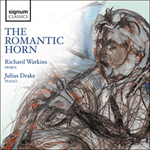The
Élegie for horn and piano was composed in 1957 in memory of the famous English horn-player, Dennis Brain. It represents the briefest of a dyed-in-the-wool tonal composer’s flirtation with the 12-tone system. Poulenc had met Schoenberg in the days of Les Six and followed his music with avid interest – as he did that of all his contemporaries – without ever being tempted to emulate him. He was fascinated by Schoenberg’s work and could admire it, but it remained totally foreign to his own musical formation and personality. The years following the Second World War saw a recrudescence of 12-tone activity, and ‘serialism’ became the fashionable musical byword. Poulenc remained an observer. The nearest he allowed his own music to approach it was in this
Élegie which begins with the clear enunciation of a 12-note theme by the solo horn. A short and strongly accented ‘Agitato molto’ divides it from the piano’s different arrangement of the disjunct 12-note monody and a transposed return of the agitation. This is all preludial. The Elegy proper maintains a gentle accompanimental pulse of quavers in 3/4 time. Above it, the solo horn’s wide-ranging melisma falls into clearly defined phrases without ever suggesting the initial tone-row. After a momentary reminder of the agitation, the Elegy rises with occasional and unexpected harmonic asperity to a climax from which it gradually recedes. The horn’s final utterance is another unrelated 12-tone sequence ending on the leading-note of the C major harmony on which it is cushioned. Poulenc’s
Élégie, qualifying him no more a member of the 12-tone school than Rameau, in whose music, too, a 12-note series may be found, remains essentially tonal.
from notes by Felix Aprahamian © 1999
L’
Élégie pour cor et piano fut composée en 1957, en mémoire du fameux corniste anglais Dennis Brain. Elle constitue le plus bref des flirts tonals bon teint du compositeur avec le système dodécaphonique. Poulenc, qui avait rencontré Schônberg à l’époque des Six, suivit sa musique avec un intérêt avide – comme il le fit pour le travail de tous ses contemporains – sans jamais être tenté de l’imiter. L’œuvre de Schônberg fascina Poulenc, le laissa admiratif, mais demeura totalement étranger à ses propres personnalité et formation musicales. Les années qui suivirent la Seconde Guerre mondiale virent une recrudescence de l’activité dodécaphonique, et le «sérialisme» devint synonyme de musique à la mode. Poulenc demeura un observateur, et son
Élégie – qui commence par la claire énonciation d’un thème de douze notes, au cor solo – fut sa pièce la plus proche de ce courant. Un «Agitato molto», bref et fortement accentué, marque la séparation d’avec l’arrangement pianistique, différent, de la monodie de douze notes disjointes – suivi d’un retour transposé de l’agitation. Tout ceci n’est que prélude. L’
Élégie maintient un doux rythme accompagnant, en croches, à 3/4. Par-dessus, l’ample mélisme du cor solo se répartit en phrases clairement définies, sans même suggérer la série tonale initiale. Passé un momentané répit de l’agitation, l’
Élégie s’élève, avec une aspérité harmonique aussi occasionnelle qu’inattendue, pour atteindre à un apogée, dont elle s’éloigne ensuite progressivement. L’énonciation finale du cor est une nouvelle séquence dodécaphonique disjointe, qui s’achève sur la sensible de l’harmonie en ut majeur lui servant d’assise. L’
Élégie, qui ne fait pas plus entrer Poulenc que Rameau – chez qui une série de douze notes est également trouvable – dans l’école dodécaphonique, demeure fondamentalement tonale.
extrait des notes rédigées par Felix Aprahamian © 1999
Français: Hypérion
Die
Élégie für Horn und Klavier wurde 1957 zum Andenken an den bekannten englischen Hornisten Dennis Brain komponiert. Sie stellt die kurze Liebäugelei eines eingefleischten tonalen Komponisten mit der Zwölftontechnik dar. Poulenc hatte zur Zeit der Gruppe Les Six Schönberg kennengelernt und mit lebhaftem Interesse – das er all seinen Zeitgenossen entgegenbrachte – die Entwicklung seiner Musik verfolgt, ohne je in Versuchung zu geraten, ihm nachzueifern. Er war von Schönbergs Schaffen fasziniert und konnte es bewundern, doch blieb es seiner eigenen musikalischen Ausformung und Persönlichkeit völlig fremd. In den Jahren nach dem Zweiten Weltkrieg erfolgte ein Wiederaufleben der Zwölftontechnik, und “Serialismus” kam als musikalisches Schlagwort in Mode. Poulenc verfolgte das alles nur als Beobachter. Seiner eigenen Musik erlaubte er keine größere Annäherung als jene der
Élegie, die mit der eindeutigen Formulierung eines Zwölftonthemas durch das Solohorn beginnt. Ein kurzes, stark akzentuiertes “Agitato molto” trennt es von der anderen eigenständigen Zwölftonmonodie des Klaviers und vom transponierten Wiedereinsetzen der erregten Grundstimmung. Aber das alles ist nur Vorspiel. Die eigentliche
Elegie hält einen sanften Begleitpuls aus Achteln im 3/4-Takt durch. Darüber zerfällt das weitschweifige Melisma des Solohorns in klar abgegrenzte Phrasen, ohne je auf die anfängliche Tonreihe zurückzukommen. Nach einer flüchtigen Erinnerung an die Erregung schwingt sich die
Elegie mit gelegentlicher und unerwarteter harmonischer Schroffheit zu einem Höhepunkt auf, von dem sie allmählich wieder zurückweicht. Die letzte Äußerung des Horns ist eine weitere unabhängige Zwölftonreihe, die auf dem Leitton des C-Dur-Akkords ausklingt, auf den sie gebettet ist. Poulencs
Élegie, die ihn ebensowenig zum Zwölftöner qualifiziert wie Rameau, in dessen Musik auch die eine oder andere Zwölftonreihe zu finden ist, bleibt im wesentlichen tonal.
aus dem Begleittext von Felix Aprahamian © 1999
Deutsch: Anne Steeb/Bernd Müller


 The romantic horn
The romantic horn
